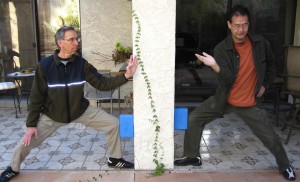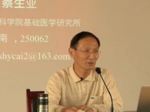When Master Chen visited Phoenix from Jan 31 to Feb 3, 2011, he introduced this new exercise to me. When you do the circles, put a yoga block between your knee and the wall, and use your knee to push very hard against the block. So, when you start to do circles, your knee is stationary. Your kua opens! Try it with the block, try it without. Eventually, you can do the circles without moving your front knee.The function of this block is that it allows free push of the body and kua forward and yet, the force transmits to the ground from the knee. Without it, the force applied forward will go out from the knee and not into the ground.
Taiji movements require that force only goes to the ground, impact goes into the opponent. This is another aspect of the yin yang separation. Many people are aware of this principle and yet they cannot produce the effect. The reason is because they do not have a physical way of actualizing the theory. This is one of the special abilities of Master Chen Zhonghua. He believes, like his master Hong Junsheng, that in learning one must not trust themselves. They should find ways to ensure what is believed is actually done.  In this excise, I have seen Master Chen teach the principle of not moving the knee before and have also seen that everyone was moving the knee right in front of him (Master Chen). The reason, Master Chen said, is because people tend to believe in what they feel. They FEEL that their knees don’t move but in reality the knees move a lot. The introduction of the block in between the knee and the wall is a personal invention of Master Chen, I believe. But the important point is that the use of this simple device actually keeps us closer to what Hong Junsheng taught. I tried it for less than a month, now I can get the same feeling about my qua and knee when doing circles without the yoga block. To keep the front knee not moving is important. To push forward without moving (forward). I urge practitioners to find ways to “force” our body to do what we believe we should do; not just believing we are doing it. This is true “Body and Mind” connection!
In this excise, I have seen Master Chen teach the principle of not moving the knee before and have also seen that everyone was moving the knee right in front of him (Master Chen). The reason, Master Chen said, is because people tend to believe in what they feel. They FEEL that their knees don’t move but in reality the knees move a lot. The introduction of the block in between the knee and the wall is a personal invention of Master Chen, I believe. But the important point is that the use of this simple device actually keeps us closer to what Hong Junsheng taught. I tried it for less than a month, now I can get the same feeling about my qua and knee when doing circles without the yoga block. To keep the front knee not moving is important. To push forward without moving (forward). I urge practitioners to find ways to “force” our body to do what we believe we should do; not just believing we are doing it. This is true “Body and Mind” connection!




{ 5 comments… read them below or add one }
Great article Ping! I am looking forward to trying it.
Thanks for sharing.
Regards.
I’m not that good at writing. Master Chen edited it for me, of course.
Master Chen advised me to take some credit for this exercise. With his input I have produced a prototype “knee holder” that allows one to practice this exercise anywhere on a floor. It is not in the final version yet, but in the meantime as long as you can use a bench or an immovable chair that allows the foot to be placed permitting the knee to be at approximate right angles, you can get the same effect. The Yoga block, however, forces you to exert pressure forward and down just to keep the block in place which is an excellent starting point for correctly using and immobilizing the front knee. No movement is permitted while still exerting correct force, direction and pressure.
Great article! The use of yoga block in order to keep the knee in locked position! Hv no yoga blocks but will try Allan’s method i.e. improvise: knee against the wt-lifting bench while doing exercises to see if knee in locked position! Tks for sharing, Allan Belsheim.
Hello Ping,
Looking at the photos i realise what i was doing wrong practising this in the gym over the last few weeks. The Yoga block must be used with a pillar so your arms can do the six sealing four closing that you mention. Is this correct?
I did it against the wall with the Yoga block but i had my arms hitting the wall, so i had to change angle, which made the original stance difficult. I knew i was doing something wrong.
It would be excellent if this was on video, but if it cannot am i right in thinking that you do need an area where the upper body is free? or am i missing something?
Thank you.